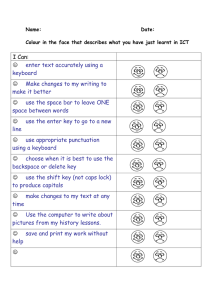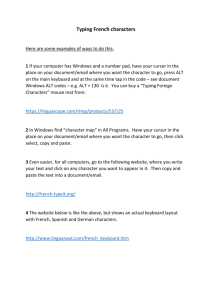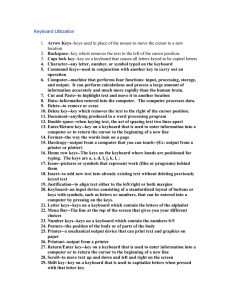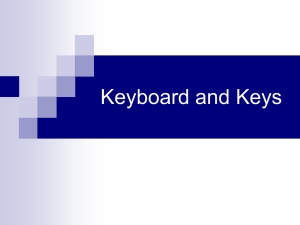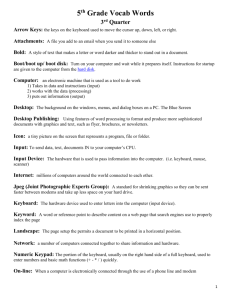Keyboard Use Vocabulary Arrow Keys 2. Backspace
advertisement
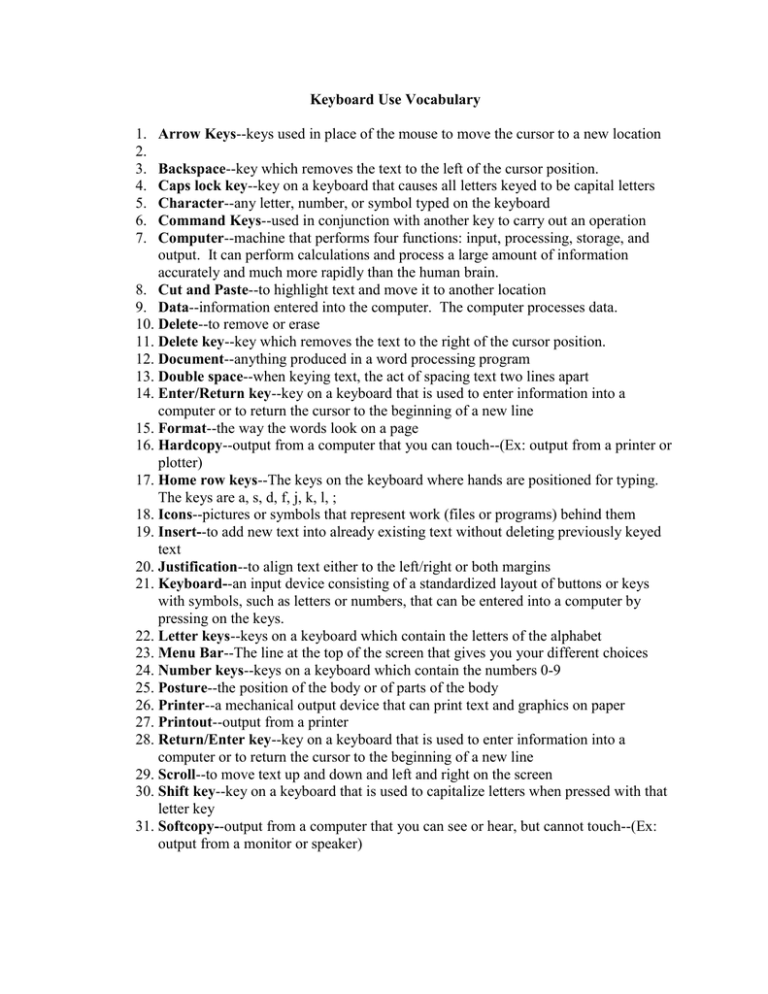
Keyboard Use Vocabulary 1. 2. 3. 4. 5. 6. 7. Arrow Keys--keys used in place of the mouse to move the cursor to a new location Backspace--key which removes the text to the left of the cursor position. Caps lock key--key on a keyboard that causes all letters keyed to be capital letters Character--any letter, number, or symbol typed on the keyboard Command Keys--used in conjunction with another key to carry out an operation Computer--machine that performs four functions: input, processing, storage, and output. It can perform calculations and process a large amount of information accurately and much more rapidly than the human brain. 8. Cut and Paste--to highlight text and move it to another location 9. Data--information entered into the computer. The computer processes data. 10. Delete--to remove or erase 11. Delete key--key which removes the text to the right of the cursor position. 12. Document--anything produced in a word processing program 13. Double space--when keying text, the act of spacing text two lines apart 14. Enter/Return key--key on a keyboard that is used to enter information into a computer or to return the cursor to the beginning of a new line 15. Format--the way the words look on a page 16. Hardcopy--output from a computer that you can touch--(Ex: output from a printer or plotter) 17. Home row keys--The keys on the keyboard where hands are positioned for typing. The keys are a, s, d, f, j, k, l, ; 18. Icons--pictures or symbols that represent work (files or programs) behind them 19. Insert--to add new text into already existing text without deleting previously keyed text 20. Justification--to align text either to the left/right or both margins 21. Keyboard--an input device consisting of a standardized layout of buttons or keys with symbols, such as letters or numbers, that can be entered into a computer by pressing on the keys. 22. Letter keys--keys on a keyboard which contain the letters of the alphabet 23. Menu Bar--The line at the top of the screen that gives you your different choices 24. Number keys--keys on a keyboard which contain the numbers 0-9 25. Posture--the position of the body or of parts of the body 26. Printer--a mechanical output device that can print text and graphics on paper 27. Printout--output from a printer 28. Return/Enter key--key on a keyboard that is used to enter information into a computer or to return the cursor to the beginning of a new line 29. Scroll--to move text up and down and left and right on the screen 30. Shift key--key on a keyboard that is used to capitalize letters when pressed with that letter key 31. Softcopy--output from a computer that you can see or hear, but cannot touch--(Ex: output from a monitor or speaker) 32. Software--instructions on a disk that make the computer work. It tells the computer (CPU) what to do. Software programs are usually stored on disks until needed. Often the disk containing the program is called software. 33. Space bar--key on a keyboard that spaces the cursor forward one space at a time and produces a blank space when pressed 34. Special Function Keys--keys that carry out specific things (Ex: Shift keys, Return/Enter keys, Caps Lock key) 35. Strike--to tap or press the keys of a keyboard with a finger or thumb 36. Symbol key--key on a keyboard that contains a symbol 37. Tab key--a key used to indent text in a line; can also be used to set-up columns in a document 38. Text--another name for alphabetical data that was entered 39. Title Bar--The line near the top of the screen that gives the name of your file 40. Word Wrap--letting the computer decide where to end each line (typing text without pushing return/enter at the end of each line) Word Processing/Desktop Publishing Vocabulary 1. 2. 3. 4. 5. Center--to place text horizontally or vertically in the middle of a page Character--any letter, number, or symbol typed on the keyboard Clip Art--picture files that can be pasted into a document Command Keys--used in conjunction with another key to carry out an operation Copy and Paste--to highlight text, leave it where it is, and also put a copy of it in another location 6. Cursor--a highlighted mark (sometimes blinking) on the screen that indicates the user's location. It indicates where the next letter or character will appear when keyed. Sometimes the cursor is a special picture or icon. 7. Cut and Paste--to highlight text and move it to another location 8. Data--information entered into the computer. The computer processes data. 9. Desktop Publishing--A computerized layout program that integrates graphics and text to produce a professional looking document. 10. Digitized effects--to change analog information into digital information that the computer can use to produce certain effects. For example, when a picture is scanned, the picture image is digitized. This means that the picture image is converted to a digital or numerical format. 11. Document--anything produced in a word processing program 12. Edit--to make changes to a document or other file 13. File--a word processing document 14. Font--a design style for a complete set of letters, numbers and symbols 15. Format--the way the words look on a page 16. Grammar checker--software program that checks for possible grammar mistakes. Suggestions or corrections are often given. 17. Graphics--pictures that can be inserted into a document 18. Hardcopy--output from a computer that you can touch--(Ex: output from a printer or plotter) 19. Home row keys--The keys on the keyboard where hands are positioned for typing. The keys are a, s, d, f, j, k, l, ; 20. Icons--pictures or symbols that represent work (files or programs) behind them 21. Justification--to align text either to the left/right or both margins 22. Laser printer--a printer that produces high quality images using a method similar to that of a photo copying machine 23. Layout--the physical placement of text and graphics in a document 24. Load--To enter a program or file into a computer's memory 25. Menu Bar--The line at the top of the screen that gives you your different choices 26. Move--rearrange text in a document 27. Printout--output from a printer 28. Retrieve--to load a previously saved file from a diskette or hard drive 29. Save--to store a file on diskette or hard drive for future use 30. Scanner--a peripheral device that converts text or pictures into bit-mapped data that is put into a computer. The digitized images can then be edited. 31. Scroll--to move text up and down and left and right on the screen 32. Softcopy--output from a computer that you can see or hear, but cannot touch--(Ex: output from a monitor or speaker) 33. Special Function Keys--keys that carry out specific things (Ex: Shift keys, Return/Enter keys, Caps Lock key) 34. Spell Checker--part of a word processing program that uses a disk-based dictionary to check and correct misspellings in documents 35. Tab key--a key used to indent text in a line; can also be used to set-up columns in a document 36. Thesaurus--a tool that helps you find words with similar meanings 37. Title Bar--The line near the top of the screen that gives the name of your file 38. Toolbox--a collection of drawing and painting tools 39. Word Processing--a computerized method of writing, editing, saving, and printing text
